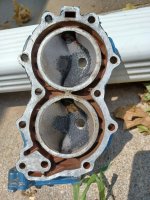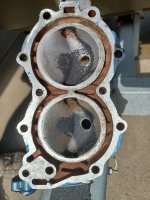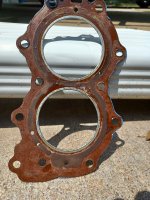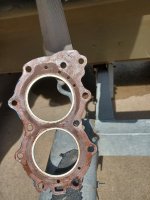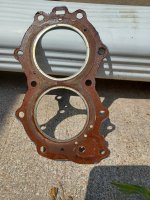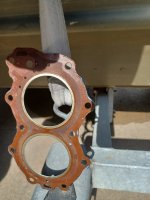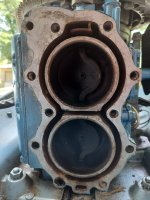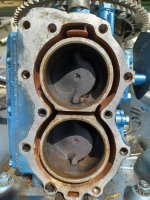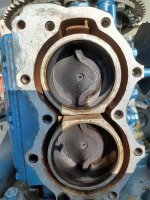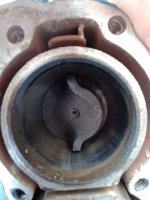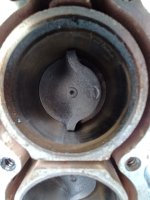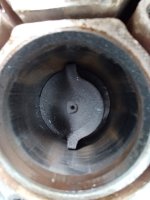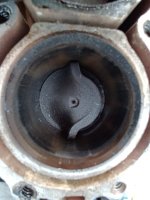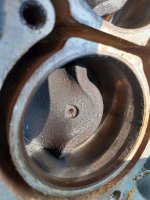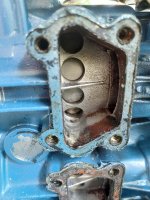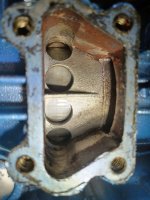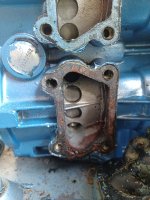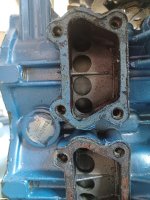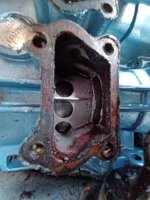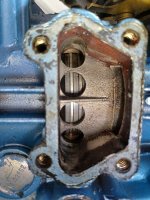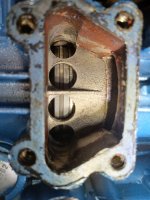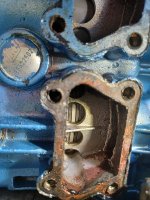For two years I've owned a 1967 rope-start Evinrude 18hp with a carb from a 25. I bought it from a part-time mechanic who claimed that made it a 25hp. I've since learned--through this forum--that installing a 25 carb on an 18 does NOT make it a 25.
In any event, the motor ran fine when I bought it in late 2021. Last year (2022) I only used it a couple of times. This year (2023) has been a different story. The first time I took it to a local lake, it wouldn't start. I figured my fuel had gone bad over the winter. I drained the tank and made a gallon of fresh fuel (50:1 no-ethanol gas and TW-C3 Lucas oil), plus half a bottle of Sea Foam. Took it to the lake again. This time it started but wouldn't idle; it just kept dying. I finally got away from the ramp by putting it in forward gear, then starting it and immediately taking off. I got out to the middle of the lake at WOT when it suddenly died and wouldn't start again. I had to row back to the ramp.
Understand that I have little mechanical experience and low mechanical aptitude. I limp along with the help of forums like this, and YouTube. My son-in-law is the opposite. He suggested I rebuild the carb. I had never rebuilt a carb but bought a kit and did it, following instructions from Max Wawrzyniak <https://www.duckworksmagazine.com/06/columns/max/index10.htm> and a couple of YouTube videos. The carb seemed very clean and had a plastic float. But it did have a tiny scrap of paper towel or rag in the inlet to the bowl. I put in the kit parts, re-installed the carb, and adjusted the low-speed needle per instructions, running the motor at home with a garden hose and flush plate adapter.
I took it to the lake again. It started and idled okay. Took a few pulls at first to start, then idled a little rough. I tried to fine-tune the low-speed needle but never got it as smooth as I wanted. In any event, it ran fine at different speeds and started a half a dozen times without difficulty.
A week later I took it to the lake again. This time it was very difficult to start and idled poorly. I was on a no-wake lake so couldn't run it more than about 1/3 throttle. I took it home and installed the flush plate so I could test it in my driveway. It was again very difficult to start and now wouldn't run for more than a few seconds without dying, despite trying different low-speed needle settings.
I read over threads on this forum about diagnosing hard-to-start and poor-running motors like mine. Yesterday I bought an adjustable spark tester and borrowed a compression tester from an auto-parts store. The spark jumped more than a 1/4" gap although it looked white, not blue. The spark plugs are NGK B6S, which are supposed to be equivalent to a Champion J6C. Both the center and ground electrodes look wet and black. Since the engine won't run, I couldn't warm it up before doing a compression test, but the engine was sitting outside on a 90-degree day. I got 60 psi both cylinders. I've read on this forum that 90 lbs is a minimum for good compression. So 60 sounds bad. Is it? If so, why was the engine running fine just a couple of weeks ago? Any other suggestions?
In any event, the motor ran fine when I bought it in late 2021. Last year (2022) I only used it a couple of times. This year (2023) has been a different story. The first time I took it to a local lake, it wouldn't start. I figured my fuel had gone bad over the winter. I drained the tank and made a gallon of fresh fuel (50:1 no-ethanol gas and TW-C3 Lucas oil), plus half a bottle of Sea Foam. Took it to the lake again. This time it started but wouldn't idle; it just kept dying. I finally got away from the ramp by putting it in forward gear, then starting it and immediately taking off. I got out to the middle of the lake at WOT when it suddenly died and wouldn't start again. I had to row back to the ramp.
Understand that I have little mechanical experience and low mechanical aptitude. I limp along with the help of forums like this, and YouTube. My son-in-law is the opposite. He suggested I rebuild the carb. I had never rebuilt a carb but bought a kit and did it, following instructions from Max Wawrzyniak <https://www.duckworksmagazine.com/06/columns/max/index10.htm> and a couple of YouTube videos. The carb seemed very clean and had a plastic float. But it did have a tiny scrap of paper towel or rag in the inlet to the bowl. I put in the kit parts, re-installed the carb, and adjusted the low-speed needle per instructions, running the motor at home with a garden hose and flush plate adapter.
I took it to the lake again. It started and idled okay. Took a few pulls at first to start, then idled a little rough. I tried to fine-tune the low-speed needle but never got it as smooth as I wanted. In any event, it ran fine at different speeds and started a half a dozen times without difficulty.
A week later I took it to the lake again. This time it was very difficult to start and idled poorly. I was on a no-wake lake so couldn't run it more than about 1/3 throttle. I took it home and installed the flush plate so I could test it in my driveway. It was again very difficult to start and now wouldn't run for more than a few seconds without dying, despite trying different low-speed needle settings.
I read over threads on this forum about diagnosing hard-to-start and poor-running motors like mine. Yesterday I bought an adjustable spark tester and borrowed a compression tester from an auto-parts store. The spark jumped more than a 1/4" gap although it looked white, not blue. The spark plugs are NGK B6S, which are supposed to be equivalent to a Champion J6C. Both the center and ground electrodes look wet and black. Since the engine won't run, I couldn't warm it up before doing a compression test, but the engine was sitting outside on a 90-degree day. I got 60 psi both cylinders. I've read on this forum that 90 lbs is a minimum for good compression. So 60 sounds bad. Is it? If so, why was the engine running fine just a couple of weeks ago? Any other suggestions?




















